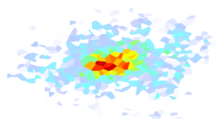5. Acknowledgments¶
Many contributions in a variety of forms have greatly helped in the development, implementation, and use of ShakeMap. ShakeMap is just one end product of a very sophisticated seismic network. Credit is given to all involved with the regional and national networks in the United States working under the auspices of the USGS Advanced National Seismic System (ANSS).
Much of the early conceptual development of ShakeMap benefitted greatly from discussions with Professors Kanamori and Heaton at Caltech. Both the TriNet Steering and Advisory Committees also provided ongoing oversight and feedback in the early years of TriNet. Discussions with many colleagues, including Woody Savage, Ken Campbell, Robert Nigbor, and Mark Petersen, provided additional guidance. Early trips to the Japanese Meteorological Agency (JMA), and in particular discussions with Keiji Doi, were also helpful.
Early ShakeMap webpages survived substantial traffic spikes due to the ingenuity and vigilance of Stan Schwarz (USGS, Pasadena). Many aesthetic improvements and integration of the ShakeMap webpages into the USGS Earthquake Hazards Team webpage standard templates were guided by Lisa Wald (USGS, Golden). Later implementations were greatly improved by the Haz-Dev Web Team, particularly by Jeremy Fee and Eric Martinez. They also provide the GeoJSON and other feeds needed for automatic ShakeMap downloads. Daniel Slosky of the ShakeCast team made numerous significant improvements in the way ShakeMaps are rendered on the USGS web pages.
Vince Quitoriano did most of the development of the first version of ShakeMap and, despite being all-new code in a different programming language, the program still carries the imprint of his original work. Craig Scrivner, then at the CA Department of Mines & Geology (CDMG), contributed greatly to the initial ShakeMap software development. Pete Lombard (U.C. Berkeley) contributed to several important aspects of ShakeMap code development and Q&A, including developing the original version of plotregr.
Global ShakeMap (GSM) is run out of NEIC, Golden, CO, and is operated with the support of Kristin Marano, and Vince Quitoriano.
At regional network centers, Kris Pankow (University of Utah), Steve Malone (University of Washington), Kuo-Wan Lin (formerly CGS, now USGS, Golden), Pete Lombard (ret.), and Doug Dreger (U.C. Berkeley), Lind Gee (USGS, Menlo Park), Egill Hauksson (Caltech), Glen Biasi (Univ Nevada, Reno), and Howard Bundock (ret.), Tim MacDonald, David Oppenheimer, and John Boatwright (USGS, Menlo Park) all played a critical role in testing, providing feedback, and improving the ShakeMap system. In addition, a number of other people assisted the above colleagues in the regional ShakeMap implementation and operation.
ShakeMap ANSS Regional Coordinators
Southern California:
Robert Graves, rgraves@caltech.edu
Gary Gann, agann@usgs.gov
Northern California:
Peggy Hellweg, peggy@seismo.berkeley.edu
Utah:
Kris Pankow, pankow@seis.utah.edu
Alaska:
Natalia Ruppert, natasha@gi.alaska.edu
Matt Gardine, mgardin2@alaska.edu
Pacific Northwest:
Paul Bodin, bodin@uw.edu
Renate Hartog, jrhartog@uw.edu
Nevada:
Ken Smith, ken@seismo.unr.edu
Gabe Plank, gabe@seismo.unr.edu
Puerto Rico:
Victor Huerfano, victor@prsn.uprm.edu
We received extremely important feedback regarding the user interface from participants through a number of meetings and workshops in CA for scientific and engineering perspectives, as well as for a very wide variety of users’ perspectives. These workshops were organized by Jim Goltz and Margaret Vinci. In addition, ongoing feedback has always been abundant and provides critical advice and ideas that seeds ongoing, iterative improvements to the ShakeMap system.
Over the years, numerous student researchers contributed greatly to the operation, development, user support and many other aspects of ShakeMap, particularly developing the ShakeMap Atlas. The students include undergraduates Chloe Gustafson, Paul Geimer, Alicia Hotovec, Kendra Johnson, Rebecca Johnson, Russell Mah, Tanya Slota; graduate students Lily Seidman, Sarah Verros, Leslie McWhirter; and post-doctoral fellows Trevor Allen and Daniel Garcia.
International collaborators include Alberto Michelini, and Licia Faenza (INGV, Rome) and Carlo Cauzzi (ETH Zurich). ShakeMap Workshops help at U.C. Berkeley, the Erice, Sicily Summer School, and the annual meeting of the Seismological Society of America (2018) were very helpful in improving ShakeMap implementations around the country and around the world.
Doug Bausch (formerly FEMA) played a vital role in standardizing HAZUS loss estimates using ShakeMap input, responding to numerous national earthquake responses, and promoting the use of ShakeMap among the earthquake response and planning communities. In interfacing with HAZUS software and loss estimates, contributions from Jahar Bouabid at Durham Technology, and Charlie Kircher of Charlie Kircher Assoc. were key.
USGS colleagues Vince Quitoriano and Kuo-Wan Lin have long operated, supported, and greatly added to the development of ShakeMap. Kristin Marano of the PAGER team has also provided support for ShakeMap and the development of the latest versions of the ShakeMap Atlas. Kishor Jaiswal, Ned Field, Nico Luco, Mark Petersen have all been very helpful in software calibration and validation and overall advice.
Emmette Wald provided helpful rewivews of this Manual.
Earlier versions of ShakeMap relied extensively on the Generic Mapping Tools (Wessel and Smith, 1995). GMT is an incredibly valuable tool for the scientific community.
Worden, Thompson, and Wald would like to thank our co-authors Jack Baker, Brendon Bradley, and Nico Luco for their contributions to Worden et al. (2018), which revolutionized the way ShakeMap interpolates ground motions. The work of Peter Stafford also played an important role in understanding and conceptualizing this new methodology.
Bruce Worden would like to acknowledge the support of his employer, Synergetics Inc., in providing an environment that allows him to focus on his work for the USGS. Everyone at the company has been helpful and supportive, and Debbie Jorgenson, in particular, has been enormously gracious in sorting out the business details through the years.
Lastly, we are also extremely grateful for the recognition of the importance of ShakeMap and the ongoing internal and external support for its development at all levels within the USGS. Along the way, the support of John Filson, David Applegate, Bill Leith, Harley Benz, Cecily Wolfe, Woody Savage, Jill McCarthy, and many others has been critical.
Thank you all.
Bruce Worden, David Wald, Eric Thompson, and Mike Hearne, February 2020
